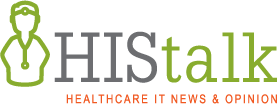Readers Write: Technology Augmented by Behavioral Science Theory Leads to Improved Health
Technology Augmented by Behavioral Science Theory Leads to Improved Health
By Rhea Sheth
Rhea Sheth is a clinical and marketing intern at Carium and an undergraduate student at the University of California, Berkeley studying integrative human biology.

Behavioral science is the study of human behavior. It asks the question: why do we act the way that we do? The simplicity of this question masks a complex science that underlies it.
Understanding human behavior has many invaluable applications in our society. If we can better understand human behavior, we can shape our policies in a way that will better engage individuals or present public health information in a way that will lead to an increased compliance rate.
The intersection of behavioral science and technology is an area of huge opportunity. With the rise of technology, there has also been a rise in the number of opportunities to move healthcare away from a fee-for-service model and instead move towards a value-based approach. The incorporation of behavioral science theory into mobile health platforms can help facilitate the movement towards more patient-centric care and improved health outcomes.
Research-backed behavior change techniques should be intentionally incorporated in digital health platforms to help individuals manage chronic disease. Influencing behavior change in chronically-ill patients is a crucial public health intervention. According to the CDC, 6 in 10 adults in the US have a chronic disease and 4 in 10 adults in the US have two or more chronic diseases.
Smartphone apps are a convenient, cost-effective way to provide behavioral interventions at the appropriate times. In addition, they help reduce healthcare disparities by increasing reach to populations who were previously unreachable due to demographic, socioeconomic, and geographic barriers.
Behavior change techniques can be woven into virtual healthcare tools to help users identify and manage negative behaviors that may be contributing to worsened health outcomes. Self-monitoring is one of the techniques that enable this type of positive behavior change and has been found to lead to reduced hospitalization and readmission rates.
In the context of healthcare, this includes tracking metrics indicative of health-related behaviors such as calories eaten, weight change, and blood pressure levels, often collected through devices such as wearables and fitness trackers. Through digital health platforms, users can track their desired metrics in which they can also see short-term and long-term trends in their health data. This data can be shared with care teams and providers can then keep track of their patients’ health metrics through remote patient monitoring (RPM).
According to the American Heart Association, through RPM, providers can obtain a more holistic view of the patient’s health through data, gain insight into a patient’s adherence to treatment, and develop a deeper patient-provider relationship. RPM can also help reduce healthcare costs by enabling timely health interventions before a patient’s health deteriorates to the point of requiring a costly procedure.
Before the rise of mobile health, self-monitoring was done primarily through paper journal methods, where participants would manually record entries such as calories eaten, blood pressure readings, and blood sugar levels. With recent advances in mobile technology, there are opportunities for more convenient, real-time self-monitoring. Rather than having to carry around a bulky paper journal, individuals can simply enter their data into a mobile device and see their short- and long-term trends.
For an individual with diabetes, taking a daily measurement of blood sugar can help increase awareness about their positive or potentially harmful behaviors. Seeing a huge spike in blood sugar one morning can cause the individual to, first of all, be aware that there is a change in their health, and then reflect on what actions could have caused that. They might remember that they ate three fudge sundaes last night and did not go on their daily walk. The question is, are they now likely to change their behavior?
Here’s where behavioral science comes in again. The act of self-monitoring has increased the probability of behavior change by making the individual aware that there is a change in their health. However, the act of self-monitoring does not guarantee that someone will change their behavior. The next day, the individual may have a craving for ice cream and engage in harmful behavior again.
While they may be aware now that eating ice cream is affecting their blood sugar in such a drastic manner, there may be other underlying factors that cause the individual to perpetuate a negative behavior. It may be that the individual does not understand the consequences of having high blood sugar because they haven’t received information regarding its risks. It may be that they are lonely and feel like no one cares about their health because they do not have frequent access to a healthcare professional. Or, it may be that the individual has a goal of reducing blood sugar but does not know how to achieve that goal and thus becomes demotivated.
To help mitigate the risk of perpetuated negative actions, mHealth apps can integrate different behavior change techniques with self-monitoring to enhance user engagement and increase the probability of behavior change, such as secure messaging and educational materials. Secure messaging is one way for providers and patients to interact and strengthen their relationship, and learning materials such as diabetes-self management education also help improve health outcomes.
Studies show that self-monitoring is more effective in improving health outcomes when used in conjunction with other behavior change techniques in this manner. Self-monitoring was also found to lead to reduced hospitalization and readmission rates.
Making sure technology caters to the complexity of a human being is imperative. Behavior change techniques help us do that. There is no one-size-fits-all solution for behavior change, but intentionally designing technology based on research-backed behavior change techniques has been shown to improve health outcomes. In this way, we make movement away from episodic transactional healthcare and instead towards mutually beneficial, patient-centered, and holistic healthcare.
Much like having a trainer at the gym can motivate people to reach their fitness goals and feel stronger, more confident, and successful, having a digital health platform with specific behavior techniques such as self-monitoring, health coaching, prompts / reminders to take medication, and motivational messages can help patients achieve their health goals.





 .
. 










RE: Change HC/RansomHub, now that the data is for sale, what is the federal govt. or DOD doing to protect…